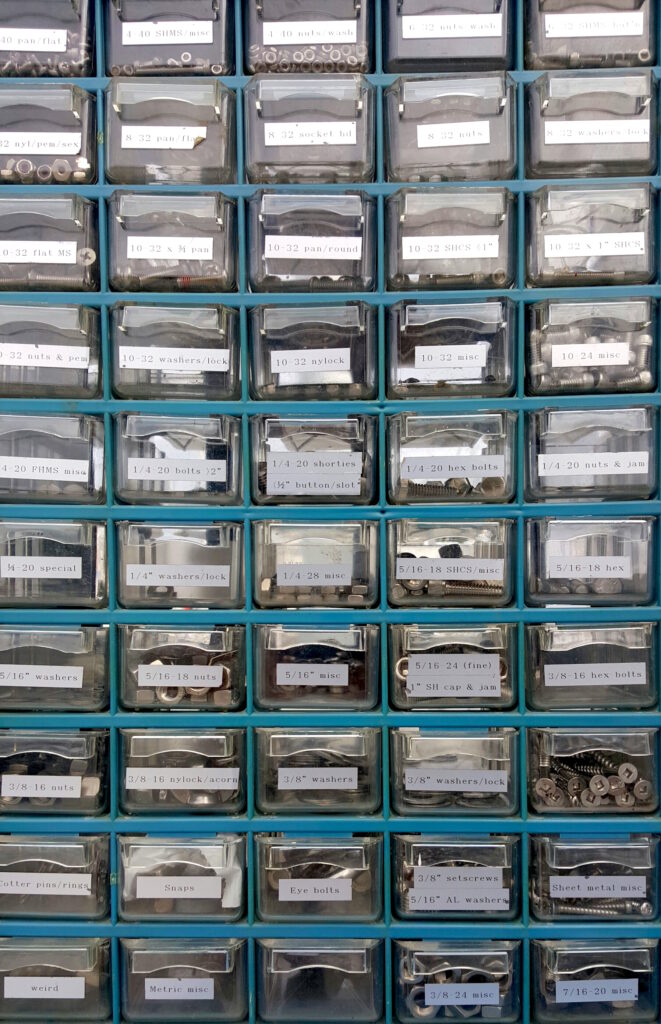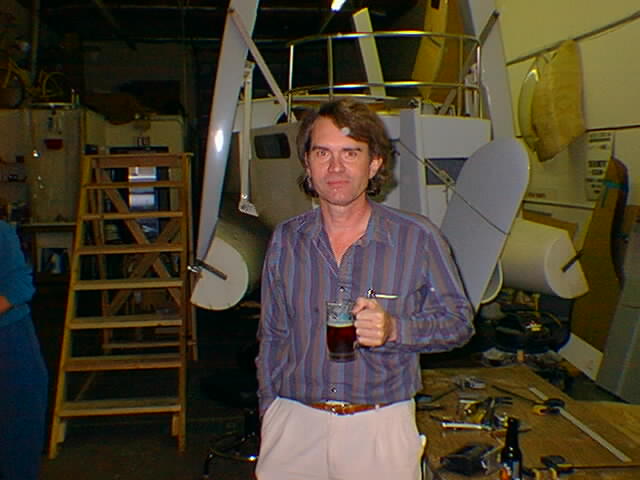
Microship Status 96 – Dev Team Forming
by Steven K. Roberts
Nomadic Research Labs
Santa Clara, California
February 13, 1996
Development Team Forming…
Hello from the Microship lab! This is a posting I’ve been looking forward to for quite a while, but it had to wait for the establishment of the new lab and a few basic tools. So now that we’re all settled into Silicon Valley, have a suitable team-tracking database (in FileMaker Pro), and a growing document of tasks that can be shared, it’s time to make this announcement…
The Microship project is ready to grow into a team effort.
It took a while to get to this point: theorizing about the ideal, yet affordable, technomadic multihull hardly called for a development team beyond a few nautical friends and naval architects, even though some of the control systems were well-defined enough to provide student-project material at UCSD. But now, the boat is here, the design is stable, we have a lab (thanks, Apple!), and the goals are clear.
A brief retrospective is in order. The BEHEMOTH project went through a similar transition from vagueness to clarity, and during the final 18 months in the lab at Sun Microsystems, the force that kept it moving forward was the involvement of other people. They came from all over (about 45 of them, all told), motivated by a variety of interests — challenge, desire to meet other creative people, a chance to do real hacking/engineering outside the constraints of corporate management, access to interesting new technologies, vicarious involvement in adventure, or the simple desire to get me out of town ;-). The result was an amazingly creative and diverse community that took on a life of its own… a pool of multidisciplinary wizardry. Lasting friendships formed, epic hacks that I never could have built by myself came to life, and prodigious quantities of Tony & Alba’s pizza and beer were consumed.
Well, we’re back, more organized than before, and a new team is forming. There are already 20 people in the database, and we need dozens more. 37 CDT’s (Clearly Defined Tasks) are listed in a “jobjar” document, ranging in difficulty from the trivial to the daunting, and there are hundreds more ahead. Some of these can even be handled by people far away, though the best synergy comes from an active on-site volunteer development team.
If you’d like a chance to help integrate state-of-the-art technology into a folding solar escape pod, please drop me a line with a few words about your background, skills, interests, and available time. We’ll be hosting an invitation-only get-acquainted party some Saturday afternoon in the next 2-3 weeks, and I can promise all sorts of rewards for your participation:
- Wide range of learning experiences
- Involvement with some of the Valley’s brightest people
- Rotating schedule of guest slots on test sails
- Occasional access to hand-me-downs or good deals on techno-toys
- The obligatory Microship Team T-shirts
- Food and drink
- Creative satisfaction
- Lasting fame ‘n glory in WWW and print publications
- Your name or company on a “Microship Team” plaque on-board
- And, of course, FUN… the true bottom line!
You know, this is such a strange enterprise… we’re surrounded here in the Valley by an intensely bottom-line oriented high-tech industry and closely-linked rampant consumerism, yet so many of the individuals who make it all happen were originally motivated by passion, curiosity, and the relentless urge to tinker and create. But however exciting the product, it often happens that employment dulls these “youthful” motivations, rendering them a sort of memory of the good old days before careers and house payments caused us to “grow up,” “settle down,” “get ahead,” and “kick back” (a confusing directional mix if ever there was one, averaging out to something disturbingly like stasis).
As you know, I sorta bailed out of all that, accepting chronic financial uncertainty in exchange for freedom, adventure, and a return to those basic “hobby” motivations that make engineering rewarding for its own sake. And that, more than anything in the above list, is the unquantifiable reward that we offer for creative involvement… the pleasure of doing something just because it’s incredibly cool to see your creation flicker to life, and because you enjoy working with other smart people for the fun of it.
Lest all this give the impression that we only want wizards fluent in the arcane arts of Deep Hacking, I hasten to add that we need help at all levels… perhaps the following will give you an idea of the range of activities ahead:
- Machining projects of all sorts (aluminum, stainless, and plastics).
- Fiberglass fabrication (glass-epoxy, vacuum bagging, surface finishing).
- Video networking and webcam development (5 on-board cameras, crosspoint, backpack transmitters, mini edit suite).
- Macintosh programming and wireless networking (spread-spectrum AppleTalk via Digital Ocean Tarpons, graphic front-end tools for the control system, navigation and mapping software, and more).
- Wireless/satellite Internet connections, and creating a land-based server that we’ll feed with telemetry blocks.
- Location- and time-stamped data collection of all sorts, ranging from hull/rigging stresses to environmental probes.
- A multitasking, multidrop FORTH control network reaching into all corners of the ship.
- 1,080 watts of solar panels, a 24-volt deep-cycle battery bank, electric thruster, power management, and PV module performance tracking.
- Multimode ham/marine radio station (VHF, UHF, HF CW/SSB, -TOR digital modes, APRS).
- GPS receivers in the backpacks with live tracking at the helm.
- Antenna hacks.
- Pressurized enclosure design.
- Efficient accommodations, tankage, galley, berthing, and stowage.
- Lab and project management.
- Web publishing.
- Errands and countless help tasks.
- CAD and VRML projects.
- Reverse-osmosis watermaker and backup solar still development.
- Satcom systems and integration with email software. Brutal test sails. Kitbuilding. Refinement of navigation tools.
- Designing and testing the neuropilot, optimizing steering with input from accelerometers to null out sea state.
- Secondary structure fabrication.
- Countless little widgets and subassemblies, fabric projects, cabling jobs, and tweaks.
- RFI/EMI chasing.
- Publications, video projects, and photo archiving of the whole project.
- And, through it all: brainstorming, wall-staring, blue-sky imaginings, armchair sailing dreams, and related nomadness that somehow fuels all the rest.
So. If you’re interested in being a part of all this, please let me know! And if you want to get involved but are not about to relocate to the Valley of Silicon just to donate your time, please let me hear from you anyway. There are definitely some subsystems that can be developed off-site, and we can always use input from people who have relevant experience. That’s the beauty of the Net…
We’ll be creating a small mailing list just for team communications, but will report on all activities in these Microship Status postings (never more often than once per week). And, for those of you who are just watching, this will be the only long post on the topic — we’ll return to our regular programming of technopassion, progress reports, and random nomadness next week!
Assorted Microship News Bits
No single project took center stage since Issue #95, so here’s a quickie update on general activity…
First, thanks go to Jake Nicol (our youngest volunteer so far, at age 11) for helping sort the stainless fastener inventory. Triangle Machinery has great prices on socket-head cap screws and related hardware… IF you’re willing to accept a bulk mix of 20-30 different types. Jake’s about a third of the way through the bin, which should save many hours of rooting through stainless over the next two years, recalling the old maxim, “If a project requires ‘n’ components, there will be ‘n-1’ units in stock.”

We also had a bit of help last week from Filippo Loddo, one of our former UCSD engineering students (the manpack project) who is now with a networking company in the East Bay. He and Faun worked together to extract another few dozen points from the boat’s deck regions — more input for Dave Berkstresser’s AutoCAD model.
Speaking of Microship visualization, we are delighted to welcome Virtus to the project, as the sponsor of WalkThrough Pro. This package combines a set of design tools for building 3-D worlds with a lovely navigation front end that allows the user to fly around, explore, and examine the resulting models. All this is exportable, of course, and a freeware player is available that will allow people to navigate around 3-D VRML models in our website. Coming soon… we’re just starting the learning curve. The package also accepts DXF files, so once we’re past the basics we may have a live boat model in short order.
The quest for new network services has yielded another new sponsor — Zocalo. Normally a Frame Relay provider over 56K leased lines, the company is setting up ARA and IP service via a dedicated pair of 28.8 modems and voice line (sort of a poor-man’s leased-line… going all the way with 56K is about $1,200 up front and $340 a month). In addition, we’re co-locating our SPARC 1+ web server at Zocalo in Berkeley, and are a few days away from moving our site (a copy has been running at UCSD since December, thanks to Trevor Henthorn) and bringing it up to date. I’ll give you the new URL as soon as it’s stable…
Qualcomm has been a tremendous help during this network transition phase: we’ve had dial-up access via PPP to the POP server (for Eudora) and the full range of net services. Once the new accounts and lines are all stable, we’ll install .forward files and throw the switch, but Qualcomm deserves major thanks for keeping us well-connected through all the travel and lab-relocation.
Halted Specialties came to our rescue again with a long-term loan of an Apple Personal LaserWriter, freeing heavily-burdened serial ports and vastly improving output quality. And AsepCo donated their old (but very nice!!!) Minolta copier and previous PBX phone system… both highly useful here in the lab.
Thanks much to all five companies!

The final bit of news is that I’ll be a luncheon keynote speaker at an interesting event in San Diego on March 28-29. Actually, I only agreed because I want to hear what everyone *else* has to say — it’s the SAE “Electric, Photovoltaic, and Hybrid Vehicle” workshop. Lots of good sessions and interesting people, but the bad news is that it’s $695 for non-members or $595 for members (and no proceedings are available to non-attendees).
That’s it for this week — thanks for your interest in the project, and do let us hear from you if you want to get involved!


You must be logged in to post a comment.